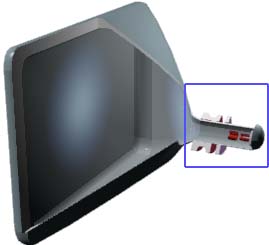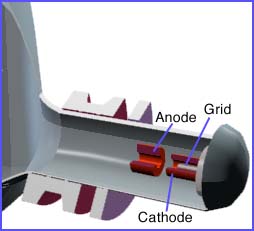Black and White TV Screens
 We keep talking about these little dots. What are they made of, anyway?
We keep talking about these little dots. What are they made of, anyway?
 That is an interesting question. There is a cathode ray tube inside
your TV. The cathode is a negatively charged plate that is heated in order to
provide enough energy to allow it to emit electrons. These electrons are
accelerated towards a positively charged plate called the anode.
That is an interesting question. There is a cathode ray tube inside
your TV. The cathode is a negatively charged plate that is heated in order to
provide enough energy to allow it to emit electrons. These electrons are
accelerated towards a positively charged plate called the anode.

|

|
 What does this have to do with those dots?
What does this have to do with those dots?
 I'm getting there. The electrons leave the anode and start out in random
directions until they pass between the cathode and the anode. The electric
force between the anode and the cathode is what produces the beam. The beam
hits the inside of your TV screen, which is coated with specks of a
phosphor. A phosphor is a type of chemical that glows when hit by an
electron. As the electrons collide with the screen, the phosphors light up.
These are the dots we have been talking about.
I'm getting there. The electrons leave the anode and start out in random
directions until they pass between the cathode and the anode. The electric
force between the anode and the cathode is what produces the beam. The beam
hits the inside of your TV screen, which is coated with specks of a
phosphor. A phosphor is a type of chemical that glows when hit by an
electron. As the electrons collide with the screen, the phosphors light up.
These are the dots we have been talking about.
 So the electron beam is what scans the phosphors and creates the image I see.
So the electron beam is what scans the phosphors and creates the image I see.
 Yes. The electron beam is focused onto different parts of the screen at
different times. As we just saw in the previous experiments, the electron beam
traverses the screen in lines. After the lines for one picture are scanned in,
the lines for the next picture are scanned in. The next picture differs from
the one before it, and persistence of vision causes them to blend and create
the impression of motion. We can see this happening in the image below.
Yes. The electron beam is focused onto different parts of the screen at
different times. As we just saw in the previous experiments, the electron beam
traverses the screen in lines. After the lines for one picture are scanned in,
the lines for the next picture are scanned in. The next picture differs from
the one before it, and persistence of vision causes them to blend and create
the impression of motion. We can see this happening in the image below.
 Actually, it is a bit more complicated than the following demonstration.
Click here to find out about interlacing.
Actually, it is a bit more complicated than the following demonstration.
Click here to find out about interlacing.

|
 Neat! In other words persistence of vision lets us see each image from a
succession of dots and also makes the images blend into motion as the
dots for the next image arrive.
Neat! In other words persistence of vision lets us see each image from a
succession of dots and also makes the images blend into motion as the
dots for the next image arrive.






